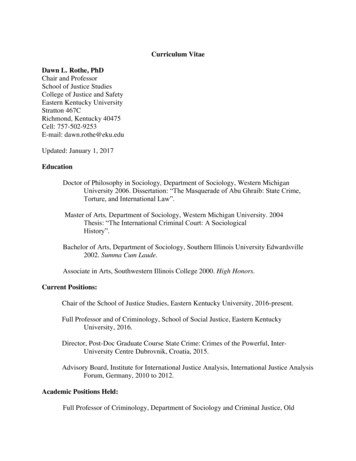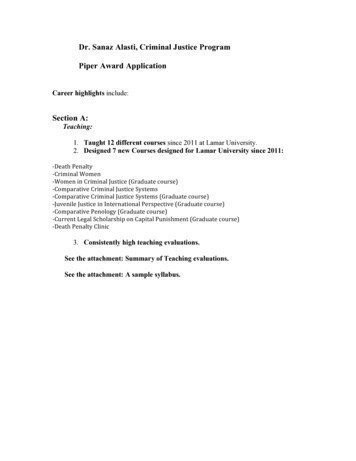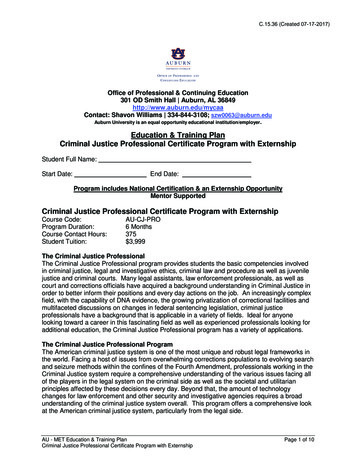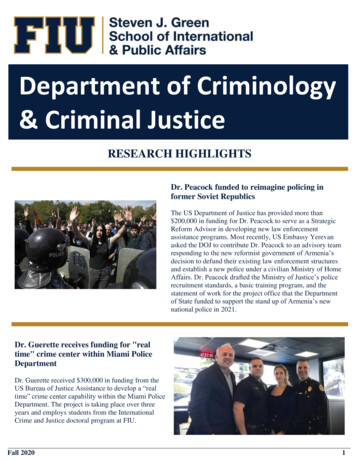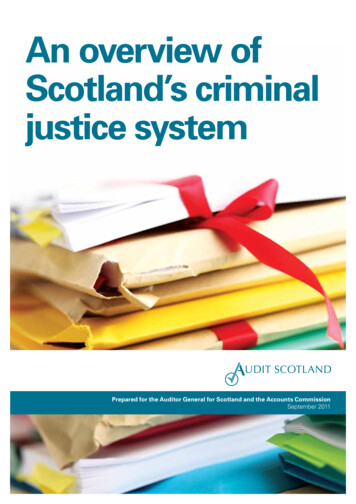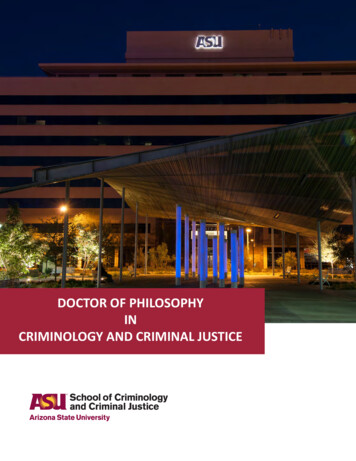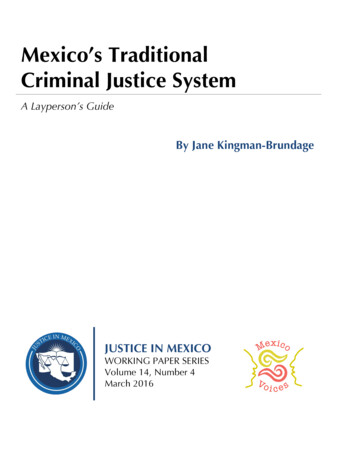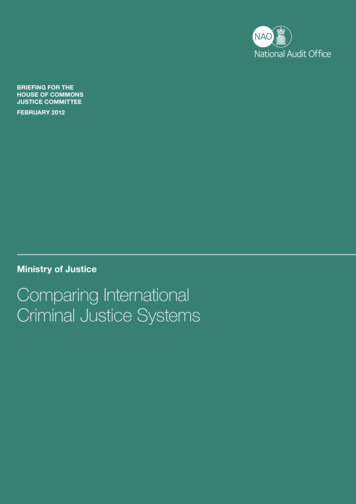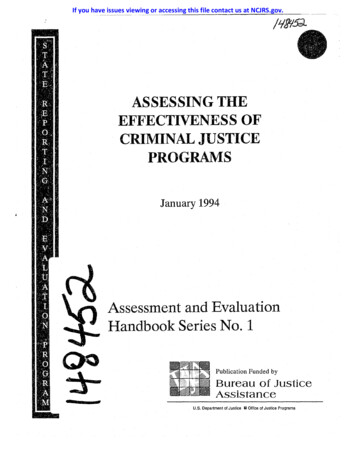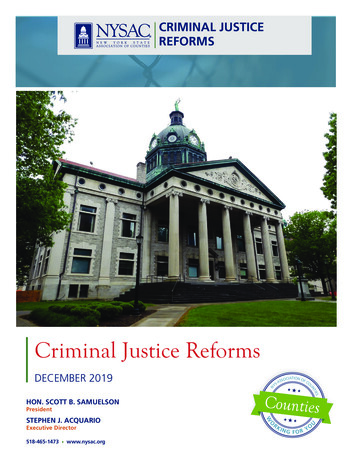
Transcription
CRIMINAL JUSTICEREFORMSCriminal Justice ReformsPresident518-465-1473 www.nysac.orgRKOExecutive DirectorCountiesWSTEPHEN J. ACQUARIO IN GUHON. SCOTT B. SAMUELSONIATION OSOCFCASOSYSTIEUNNDECEMBER 2019FORYO
Introduction The 2019-20 New York State Budget includes criminaljustice reforms that limit bail, amend the discovery and speedy trial process,change civil asset forfeiture, and improve the community reentry process. Thisreport provides a review of the reforms that will need to be implemented at thecounty level. The material has been adapted from budget language, memos, andother documents used to explain these new provisions.Current LandscapeIn a February 2019 report published by the New York State Division of Criminal JusticeServices (DCJS), 66% of the New York State jail census are un-sentenced inmates (15,067out of 22,828). In New York City, 77% of the jail population remains un-sentenced (6,463out of 8,346) compared to the rest of NYS, where 59% of the jail population remains unsentenced (8,605 out of 14,482).Recently, NYC has reduced the total number of un-sentenced inmates. However, outsideof NYC, 22 out of the 57 counties showed an increase in the percentage of un-sentencedinmates from 2009 to 2018. The counties that showed an increase include: Broome,Cattaraugus, Chautauqua, Chenango, Clinton, Cortland, Delaware, Dutchess, Fulton,Genesee, Jefferson, Livingston, Madison, Orange, Oswego, Rensselaer, Saratoga, Schuyler,St. Lawrence, Steuben, Tioga, and Wyoming. This data is representative of the currentlandscape, prior to the state enacting these reforms.2 NYSAC WINTER 2019CRIMINAL JUSTICE REFORMS
“The cost of housing New Yorkers in county jails is nearly 2.5 billion per year— 1.3 billion per year in NewYork City, and 1.15 billion per year in county jails across the rest of New York State. This is in addition tothe 3.7 billion per year New Yorkers spend annually on state prisons,” JustLeadershipUSA (2017).New York State has a lower incarceration rate compared to the average U.S. state. However, whencomparing the landscape in New York State internationally, the incarceration rate in our state alone(includes local, state and federal inmates) exceeds that of many industrialized countries (see graph below).Furthermore, in addition to the 27,000 individuals incarcerated incounty jails and 50,000 in state prisons, over 230,000 New York Stateresidents are under a form of supervision (parole or probation).The Vera Institute of Justice has provided acomprehensive report showing variousstatistics of county MINAL JUSTICE REFORMSNYSAC WINTER 2019 3
The 2019-20 Adopted BudgetElimination of Monetary Bail for Certain Offenses 1The SFY 2019-20 Adopted Budget eliminates monetary bail for people facing misdemeanorsand non-violent felony offenses. This new law is effective January 1, 2020.This measure replaces the current statute which was adopted in 1970, when it was designedto “reduce the un-convicted portion of our jail population.” Under the statute, bail wasauthorized in the current ways: cash bail; an insurance company bail bond; a surety bond;a secured appearance bond; a partially secured surety bond; a partially secured appearancebond; an unsecured surety bond; an unsecured appearance bond; or with a credit card (CPL520.10).Ending Cash BailBeginning January 2020, bail will only be available to a limited cohort of crimes deemed“qualifying offenses.” A qualifying offense includes but is not limited to: all violent felonies(except Burglary 2nd, Robbery 2nd), all Article 130 (sex releated) offenses, all non-drug class Afelonies, all felony terrorism offenses, all incest offenses, domestic violence-related contempt’s,as well as witness intimidation, witness tampering, operating as a major trafficker, conspiracyto violate Article 124, child sexual performances and luring a child. If a qualifying offense ischarged, the court will make a determination for bail if the accused poses a flight risk.For the non-qualifying offenses, this legislation mandates that police issue appearance ticketsonly (therefore not place in custody) in misdemeanor and class E felony cases with enumeratedexceptions. Some exceptions include but are not limited to: a charge with a crime betweenmembers of the same household; charged with a crime or offense involving sexual misconduct;a person is in such distress that he or she would face harm without immediate medical ormental health care.Non-qualifying offenses, which are largely comprised of misdemeanors and non-violentfelonies, will be governed under a system of pre-trial release services that include release onrecognizance (ROR) or release under the least-restrictive non-monetary conditions (LRNMC)as options for a court. Pre-trial service agencies (PTSAs) are mandated to exist in every countyin order to assist with individuals that have been released (both ROR and LRNMC). All formsof pre-arraignment bail will be abolished and there will be restrictions established on lawenforcement detaining individuals pending arraignment.In a case that involves a qualifying offense and the judge determines that the defendant isa flight risk, then the defendant can be released under non-monetary conditions. These caninclude electronic monitoring, and/or mandated check-ins with a “pre-trail services agency.”4 NYSAC WINTER 20191 Part JJJ, Revenue BillCRIMINAL JUSTICE REFORMS
The State’s Office of Court Administration (OCA) shall certify and regularly review for recertification one or morepretrial services agencies in each court to monitor principals released under non-monetary conditions. Every suchagency shall be a public entity under the supervision and control of a county or municipality or a non-profit entityunder contract to the county, municipality or the state. A county or municipality can enter into a contract with anothercounty or municipality in the state to monitor principals under non-monetary conditions of release in its county, butcounties, municipalities and the state shall not contract with any private for-profit entity for such purposes.The supervision by a pre-trial services agency may be ordered as a non-monetary condition if the court finds thatno other realistic non-monetary conditions will assure the principal’s return to court. The court or a certified pretrialservices agency shall notify all principals released under non-monetary conditions and on ROR of all court appearancesin advance by text message, telephone call, electronic mail or first-class mail.Each pretrial service agency certified by the OCA shall at the end of each year prepare, file, and publish with suchoffice an annual report on its pretrial services and make available upon request to members of the public on itswebsite.Defendant’s will be entitled to representation by counsel at any point where conditional release, bail, detention, orrelease from detention is being considered.Key ComponentsPre-Trial Services (PTSA)Counties must have PTSAs in-house or on contractPTSAs must be OCA certified and reviewedPTSAs area an option for monitoring defendants atlibertyCourt appearance reminders are mandatedLeast Restrictive Non-Monetary Conditions(LRNMC)LRNMCs may include any “condition reasonableunder the circumstances,” and specifically mayinclude restrictions on travel related to flight fromjurisdiction, restrictions on weapons possession,PTSA monitoring, and, where applicable, electronicmonitoring.Electronic Monitoring: Only available for felonies, DVmisdemeanors, Article. 130 offenses, misdemeanorswhere the defendant has prior Violent FelonyOverride in the past 4 years and “530.60(2)(b)scenarios.”CRIMINAL JUSTICE REFORMSAppearance TicketsRequired on Misdemeanors & Class E FeloniesStationhouse bail is repealed entirelyReturnable ASAP (20-day outside limit), unless diversionAT Exceptions: open warrant; FTAs within 2 yearsOP or DMV restriction; Art. 130 or DV offense; Escape3rdBail Jumping 2nd; need court assistance with a medicalissuePresumptions and ProcessIn every case, a court shall ROR unless the court makes“individualized determination” of flight risk. A court mayprogress to a higher level of securing order only whensuch a finding has been made, with its explanation onthe record or in writing.In every case, the court must utilize the least restrictiveterms to ensure a defendant’s return to court. A bailreview may be launched on grounds the court did notuse the least restrictive means.Summary of Bail Reform, Courtesy of Nassau County District Attorney’s OfficeWritten by Jed Painter, Counsel to the DA(Painter, DANC)NYSAC WINTER 2019 5
Bail ReviewAccording to Jed Painter, Council to the Nassau County District Attorney, “The laweliminates three existing considerations determining bail, including (1) the defendant’sfamily ties and length of residence in the community; (2) the weight of evidence againstthe defendant; (3) the sentence that may be imposed upon conviction. These are nolonger to be considered. In various places of the revised statute, it is noted that thepurpose of any securing order is solely to ensure a defendant’s return to court. (Painter, DANC).At the same time, superior court reviews of local criminal court bail determinations willbe expanded to allow an enumerated standard of review where the lower court “has seta securing order of release under non-monetary conditions which are more restrictivethan necessary to reasonably assure the defendant’s return to court,” (CPL 530.20).Additionally, as a court must always use the least restrictive terms to ensure a defendant’sreturn and must always explain its determination on the record or in writing, there will bea record for any superior court review. (Painter, DANC).Finally, under any conditions of release, courts are encouraged to consider a “lessening ofconditions” to a less burdensome form as the case progresses “based on the defendantscompliance with the conditions of release.” Additional conditions may be imposed on therecord or in writing only after notice and a hearing. All conditions of release must be inwriting in an “individualized written document” and explained “in plain language and amanner sufficiently clear and specific.” (Painter, DANC).Promoting Bail Alternatives*A judge must provide three different mechanisms,for a list of alternatives, for a defendant to post bail.Among those three, they must include an unsecuredor partially secured surety bond. (Painter, DANC).* The authorized alternatives of bail include cash bail,an insurance company bail bond, a secured suretybond, a secured appearance bond, a partially securedsurety bond, a partially secured appearance bond,an unsecured surety bond, an unsecured appearancebond, and a credit card or similar device.Discouraging Bench WarrantsCourts may no longer issue bench warrants immediately, but must instead delay theissuance of a bench warrant for a period of 48 hours after notice is provided to thedefendant or defense counsel.Exceptions: A new arrest or production of relevant, credible evidence demonstrating thefailure to appear was willful. (Painter, DANC).6 NYSAC WINTER 2019CRIMINAL JUSTICE REFORMS
Additional Criminal Justice Reforms Included in theAdopted BudgetIn addition to reshaping bail and pretrial detention services, the enacted budget includes additional proposals.Criminal Trial Discovery 2Criminal discovery is the process that governs when, how, and what information the District Attorney’s (DA) Officemust share with the defendent and their counsel. The enacted 2019-20 state budget requires prosecutors and thepolice to share more information, and more quickly, with the defense before a trial takes place. This includes disclosureof evidence and information favorable to the defense; intended exhibits; expert opinion evidence; witnesses’ criminalhistory information; and search warrant information will be made available to defendants in a timely and consistentmanner. The law provides prosecutors the ability to petition a court for a protective order, shielding identifyinginformation when necessary to ensure the safety of those witnesses.Under the new law, prosecutors must perform “automatic” discovery obligations no later than fifteen days after thedefendant arraignment on an indictment, superior court information, prosecutor’s information, and misdemeanorcomplaint or felony complaint. “Automatic discovery” means “all items and information that relate to the subjectmatter of the case and are in the possession, custody, or control of the prosecution.” This includes material in thepossession of the police. The prosecutor must disclose this material “as soon as practicable” within the 15 daywindow.The prosecution must disclose statements of the defendant to any defendant who has been arraigned in a localcriminal court upon a currently undisposed felony complaint charging an offense which is the subject of a prospectiveor pending grand jury proceeding no later than 48 hours before the time scheduled for the defendant to testify at agrand jury proceeding.The prosecutors must disclose the information expeditiously to the defendant upon its receipt and shall not delay if itis obtained earlier than the time period for disclosure in subdivision one of CPL 245.10.Sanctions for non-compliance of discovery can now range from preclusion of the evidence up to dismissal of charge.2 Part LLL of the Revenue BillCRIMINAL JUSTICE REFORMSNYSAC WINTER 2019 7
Speedy Trial Access 3Affording the criminally-accused a speedy trial is a constitutional right. In New York, the DAmust be ready for trial within six months of the arraignment for a felony, within ninety dayswhen the case is a Class A misdemeanor and within sixty days for a Class B misdemeanor. Thedifference in time allotted to the DA is in recognition that higher level charges may involvemore witnesses and preparation. If the DA fails to declare they are ready for trial on suchdeadlines, the charges must be dropped. However, delays not caused by the DA and/or agreedto by defense counsel can allow for these speedy trial deadlines to be extended.This legislation will obligate courts to take a more proactive role in actively advising litigantsregarding how time will be charged and will not take at face value an assertation thatthe prosecutor is ready to proceed with trial. The prosecutor must declare readiness andthe defense must be afforded opportunity to be heard on the record to affirm disclosurerequirements have been met. The legislation outlines that the court must ask the DA for“actual readiness” for trial. If the court determines that the district attorney is not ready, thestatement of readiness is not valid.The effective date for this legislation is January 1, 2020.Transforming Civil Asset Forfeiture 4The enacted budget limits asset forfeiture proceedings to cases that have reached conviction.It also expands reporting requirements for local law enforcement and district attorneys. NewYork’s current reporting procedure only requires these groups to report the total value ofassets seized and the distribution of those assets. The State Division of Criminal Justice Serviceswill expand reporting requirements to include additional information, such as demographicand geographic data, to better understand how civil asset forfeiture is used in NYS. Oncea more comprehensive data set is created, New York will then evaluate the asset forfeituresystems and make changes to fix any identified issues.The new legislation will take effect 180 days after it shall have become law and shall onlyapply to crimes which were committed on or after such date.Improving Re-entry Process 5Finally, the budget also removes outdated statutory bans on occupational licensing forprofessionals outside law enforcement, and instead, applicants will be assessed on anindividual basis.3 Part KKK of the Revenue Bill8 NYSAC WINTER 20194 Part PP of the PPGG Bill5 Part II of the PPGG BillCRIMINAL JUSTICE REFORMS
The mandatory suspension of driver’s licenses following a drug conviction will also be removed to allow people totravel to work and attend drug treatment, if the crimes did not involve driving.Prohibiting Distribution of MugshotsThis legislation also prohibits disclosure of mugshots and arrest information, and allows for increased probability ofparole for incarcerated individuals over the age of 55 who have incapacitating medical conditions exacerbated byage.The State Budget amends New York’s Public Officer’s Law 89(2)(b), which is the Freedom of Information Laws(FOIL) section that governs and lists what is to be considered “an unwarranted invasion of personal privacy ” TheState budget adds language regarding arrest or booking photographs. These photographs are commonly taken byarresting agencies (State and local police/Sherriff) as well as the booking agency (Sheriff and/State prison). Prior tothis State Budget arrest/booking photographs were considered subject to FOIL laws and therefore, typically, availableto the public upon request or proactively distributed to the public by the arresting or booking agency.The new legislation amends FOIL law by adding the following: “ disclosure of law enforcement arrest or bookingphotographs of an individual, unless public release of such photographs will serve a specific law enforcementpurpose and disclosure is not precluded by any state or federal laws.” Opinion/Guidance from the State’s Committeeon Open Government is expected in the near future regarding this change in the law.NYSAC Bail and Criminal Justice Reform TaskforceIn response to the new law, NYSAC created a Bail and Criminal Justice Reform task force to discuss implementationof this new statute. The mission of the Bail and Criminal Justice Reform task force is to help local leaders facilitatethe implementation of the new law and provide leadership, guidance, assistance and track the fiscal impact so thecounties can be fully reimbursed for the expanding impacted programs.The vision of the task force is to develop a county task force that will influence the new state law that will beimplemented at the county level.CRIMINAL JUSTICE REFORMSNYSAC WINTER 2019 9
The task force goals are to: Generate and collect concerns and recommendations from all the county departmentsthat will be affected by the new law; Report concerns and recommendations to that state to most effectively implement thisnew law; Engage local government and the state to work together to make sure the intention ofthe law is fulfilled, while providing the county departments responsible for implementationmaintain funding and assistance from the state; Produce a model that can assist all the county departments that will be affected by theimplementation of the new law.Taskforce members represent the county departments most directly affected by the law, andinclude: Bob Iusi, Warren County Probation Director (Chair) Craig Apple, Albany County Sheriff Steven Bayle, Saratoga County Probation Director & President of COPA Steven Bass, Westchester County Executive’s Office Bob Carney, Schenectady County District Attorney Tim Donaher, Monroe County Public Defender Robert A. Durr, Onondaga County Attorney Ruth Doyle, St. Lawrence County Administrator Elizabeth Glazer, Director of the NYC Mayor’s Office of Criminal Justice David Hoovler, Orange County District Attorney & President of DAASNY John Flynn, Erie County District Attorney Gene Funicelli, Putnam County Probation Director Jason Molino, Tompkins County Manager Jed Painter, Counsel to the District Attorney at Nassau County Scott Samuelson, Sullivan County Legislator & NYSAC President Mark Scimone, Madison County AdministratorThe task force has served as a vehicle to collect county concerns and feedback regardingimplementing the new criminal justice reforms (bail and discovery). To date, NYSAC has heldseven conference calls with members of our Task Force, which has helped NYSAC shape ourfiscal asks and bring awareness of potential statutory reforms to the State in order to make theimplementation process more effective and efficient.10 NYSAC WINTER 2019CRIMINAL JUSTICE REFORMS
Update on Fiscal EstimateFrom responses that we have received to date, counties are budgeting increases in both the District Attorney andProbation departments. Many of these costs include additional personnel, including crime victim advocates, ITstaff, Assistant District Attorney’s. Counties have also identified a need for additional technology needs, includingdesktop scanners, storage backup, servers, cloud-based discovery data sharing tools, etc. Some (not all) countiesfund crime laboratories that are used to process or verify discovery used in the criminal justice process. Theworkload and the costs are expected to increase for crime laboratory services due to the reforms.For the county submissions we have received to date, the financial need is about 4.00 per capita per county. Ifadditional county budgets show a similar trend, we can safely expect that these reforms will cost in the tens ofmillions of dollars for counties.Update from State Bail Reform Task ForceNYSAC has participated in three state bail reform task force meetings. This task force is spearheaded andrun by the State Executive branch and is not affiliated with the NYSAC task force. Along with other countyrepresentatives from probation and the district attorney’s offices, collectively, we have advocated for adjustmentsto the statutory language and funding for counties to implement the reforms. Specifically, the state task force isconsidering guidance on electronic monitoring and the expectation of discovery as it relates to traffic infractions.These are two areas of legislative concern that need to be addressed in order to provide some level of clarificationto counties.Outstanding Areas of ConcernElectronic monitoringWhat will be the acceptable practice and process for administering electronic monitoring to individuals who arecourt-ordered to receive this level of supervision.OCA has provided NYSAC with a letter explaining their interpretation of the statute with respect to electronicmonitoring. A copy of this letter is included as part of the appendix at the end of this document.CRIMINAL JUSTICE REFORMSNYSAC WINTER 2019 11
Regulations and guidance for pretrial servicesDCJS is working with CJA (NYC) and the NYS Association of Pretrial Agencies, to developguidance material for OCA to share with counties. This guidance was originally going to besent to counties in November. We do not know when this guidance will be released.Pretrial court notification remindersWe have been told that OCA will administer pretrial court notification reminders for allcounties with the exception of NYC. It is our understanding from OCA, that the courts will becoordinating appearance notifications for every future appearance.The document included as part of the appendix provides the process OCA is planning tofollow outside of NYC.Pre-Trial Release ProgramsIn a recent survey of Probation Directors, 40 county Probation Departments currently operatePre-Trial Release (PTR) programs and therefore we have some expertise in supervising personsplaced under pre-trial release with conditions. In the other counties with PTR programs,agencies other than Probation or local non-profits, operate those programs. There remaina number of Counties which will have to develop PTR programs from scratch to meet therequirements of the legislation. According to the annual report filed by DCJS for the contractyear July 2017 to June 2018, there were over 19,000 persons being supervised under PTRprograms. Data indicates that 51% of those interviewed while in jail were subsequentlyreleased.The presumption of release for most misdemeanors and non-violent felonies is release onrecognize with no contact or conditions of release with Pre-Trial Release (PTR) programs. Ifthe courts deviate from this standard of release on recognizance and probation departmentsbecome inundated with Release under Supervision (RUS) cases, many departments will beunable to cope with the quantity of released individuals as they simply lack the capacity todeal with this added obligation. Every person does not need specialized conditions if releasedwithout bail. PTR conditions should be minimal in nature and the least restrictive possible toensure a defendant’s appearance in court.If the expectation of this law is to have PTR become more robust and rehabilitative orientedfor these individuals prior to any conviction, then the entire philosophy and infrastructure ofthese programs need to be examined. Pretrial supervision should not be used a pre-probation“try out.” We find that many persons are placed on PTR so the court and attorneys can “seehow the person will do under community supervision”.12 NYSAC WINTER 2019CRIMINAL JUSTICE REFORMS
The NYS Criminal Procedure Law already provides for that opportunity with terms of “interim” probation. It isimperative that the courts and attorneys understand that PTSA is to ensure the individuals return to court, and nota period to determine if probation would be a viable sentencing option.NYSAC Recommendations & Policy PositionsCounties support the reforms outlined in the 2019-20 Adopted Budget. However, there will be increased costs toCounty Sheriffs, Probation Departments, and District Attorney offices. These added costs should be consideredand accounted for by the state.In addition, the State Commission on Corrections should revise the minimum staffing requirement for each localcorrectional facility as set forth in 9 CRR-NY 7041.2 NY-CRR upon implementation of this legislation to adjust forexpected reductions in local jail census. Otherwise, counties will not see a reduction in county jail costs.NYSAC urges the Governor and State Legislature to create a taskforce to understand the true costs ofimplementing these criminal justice reforms. This taskforce must work to determine the full impact to the criminaljustice system, and recommend appropriate state funding support to assist counties with continued effectiveimplementation.AttributionA special thank you to members of the District Attorney Association of New York, especially Jed Painter and theNassau County District Attorney’s Office. Their work and knowledgebase on this issue was essential to providingthese needed facts.CRIMINAL JUSTICE REFORMSNYSAC WINTER 2019 13
Appendix A14 NYSAC WINTER 2019CRIMINAL JUSTICE REFORMS
CRIMINAL JUSTICE REFORMSNYSAC WINTER 2019 15
Appendix BRev. 12/11/2019APPEARANCE NOTIFICATION TIMETABLEPeriod of timebefore nextMethod:Contact Info entered:appearance:Result:Text*Cell/Phone # (Text) / 1 day priorNO Text message sent before the appearance2-3 days priorText message sent 1 day before the appearance4-7 days priorText message sent 1 day & 3 days before the appearance-Spanish available / 8 days priorText message sent 1, 3 & 7 days before the appearanceE-MailE-Mail Address / 1 day priorNO E-Mail sent before the appearance2-3 days priorE-Mail sent 1 day before the appearance4-7 days priorE-Mail sent 1 day & 3 days before the appearance-Spanish available / 8 days priorE-Mail sent 1, 3 & 7 days before the appearanceVoice*Phone # (Voice) / 1 day priorNO Call made before the appearanceMail/Message2-3 days priorCall made 1 day before the appearance4-7 days priorCall made 1 day & 3 days before the appearance-Spanish available / 8 days priorCall made 1, 3 & 7 days before the appearance / 8 days priorNO Appearance letter automatically produced or mailedLetterMailing Address entered / 9 days priorAutomated Appearance letter produced and mailed*NOTE: If the phone number includes an Extension, there will be no notification sent through this method. Defendants who appear to beincarcerated as designated in the case management system, will NOT receive notifications.Text Message Content Example: Reminder, John Doe should appear on Monday, January 7, 2020 at 10:00AM @ Tompkins County Court located at320 N. Tioga Street, Ithaca, NY. Please show up & avoid a warrant. Questions? Reply HELP for help. To stop receiving these text messagereminders reply S to cancel.CRIMINAL JUSTICE REFORMSE-Mail Message Content Example: This is an important message on behalf of the New York State Unified Court System. John Doe has a courtappearance and must appear at Tompkins County Court on January 7,2020 10:00AM. To avoid the possibility of a warrant being issued for yourarrest, you are required to show up to the court 320 N. Tioga Street, Ithaca, NY 14850. If you have an attorney, you should consult with him or herif you have a question about this appearance in court. If you need further assistance, please contact your attorney. Alternatively, you may call the16 NYSAC WINTER 2019
Rev. 12/11/2019APPEARANCE NOTIFICATION TIMETABLEPeriod of time*NOTE: If the phone number includes an Extension,there will be no notification sent throughbefore nextthisMethod:method. DefendantsContactwhoInfo appearentered:to be incarceratedappearance: as designatedResult: in the case managementsystem,notifications.Text* will NOT receiveCell/Phone# (Text) / 1 day priorNO Text message sent before the appearance2-3 days priorText message sent 1 day before the appearanc4-7 dayspriorText messagesent 1Januaryday & 3 daysbefore the aText Message Content Example: Reminder, JohnDoeshould appearon Monday,7, 2020-Spanish available / at8 daysText message3 & 7 daysbeforeat 10:00AM @ Tompkins County Court located320priorN. Tioga Street,Ithaca,sentNY.1,Pleaseshowup the appE-Maila warrant. Questions?E-Mail Address / help.1 dayTopriorNO E-Mailsentbeforethe appearance& avoidReply HELP forstop receivingthesetextmessageremind2-3 days priorE-Mail sent 1 day before the appearanceers reply S to cancel.4-7 days priorE-Mail sent 1 day & 3 days before the appeara-Spanish available / 8 days priorE-Mail sent 1, 3 & 7 days before the appearancE-MailMessageContentExam
In a February 2019 report published by the New York State Division of Criminal Justice Services (DCJS), 66% of the New York State jail census are un-sentenced inmates (15,067 out of 22,828). In New York City, 77% of the jail population remains un-sentenced (6,463

